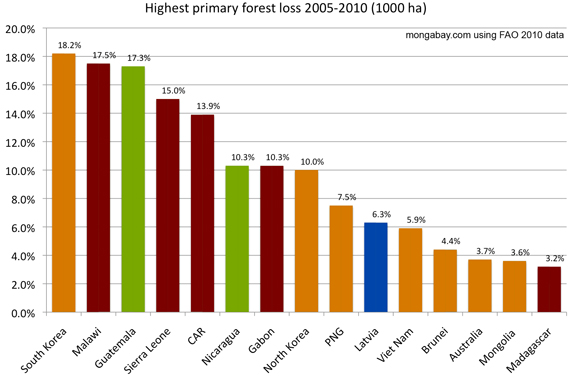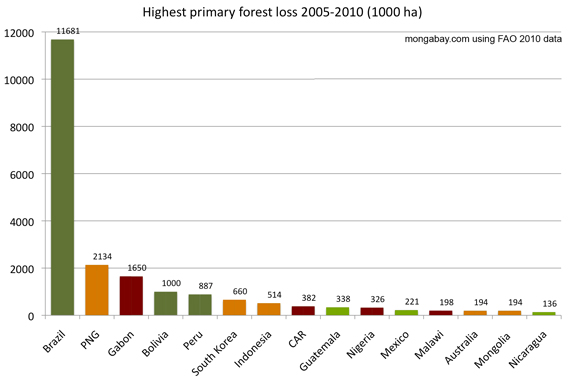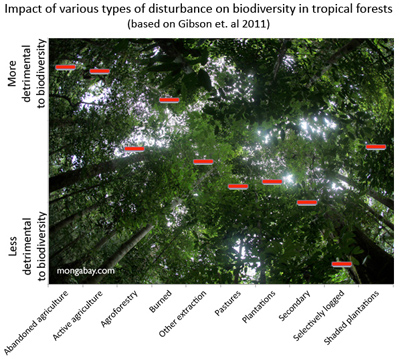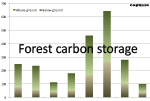Primary rainforests are top conservation priority
Old growth rainforests should be a top conservation priority when it comes to protecting wildlife, reports a new comprehensive assessment published in the journal Nature.
The research, which was led by Luke Gibson of the National University of Singapore and Tien Ming Lee of the University of California at San Diego and involved scientists from a range of international institutions, examined 138 scientific studies across 28 tropical countries. It found consistently that biodiversity level were substantially lower in disturbed forests.
“There’s no substitute for primary forests,” said Gibson in a statement. “All major forms of disturbance invariably reduce biodiversity in tropical forests.”
The research found that certain groups are more affected by forest degradation than others. Mammals seem to adapt more readily than birds and insects. The study did not assess the impact of degradation on freshwater fish, reptiles, or amphibians — groups known to be particularly sensitive to ecological change.
The findings are important because primary forests continue to fall at a rapid rate. According to the FAO, old growth forest cover declined by a minimum of 42 million hectares (162,000 square miles) — an area nearly the size of California — during the 2000s. Much of the loss was the result of selective logging, which while less damaging to biodiversity than outright conversion for agriculture, increases the vulnerability of forests to fire and future deforestation. Logging roads cut into remote forest areas typically grant access to developers, small farmers, and hunters.


Excluded from these charts are countries that lack primary forest data, including the Solomon Islands, Laos
Argentina, Paraguay, Myanmar, Malaysia, Nepal, Guyana, the United States, Canada, and India.
The authors nonetheless agree that selectively logged forests do have some conservation value and are worth protecting. A study published earlier this month in Conservation Letters argued the same point.
“As selective logging is rapidly expanding throughout the tropics, ecological restoration of such areas might represent an effective strategy to alleviate threats to biodiversity,” said co-author Lian Pin Koh of ETH Zurich.
But to conserve the maximum amount of biodiversity, the authors say old-growth forests should be a priority. They argue protected areas—despite their shortcomings—offer the best hope for primary forests.
“Primary forests are irreplaceable for sustaining tropical biodiversity,” the authors write. “Consequently,
we strongly urge their protection by enhancement of
enforcement in existing protected areas, expansion of the current network
of reserves and the curbing of international demand for forest
commodities obtained at the expense of primary forests.”
 Impact of various disturbance regimes on biodiversity in tropical forests. Chart based on Gibson et. al 2011. Photo by Rhett Butler. Click to enlarge |
But to be effective, parks must be maintained. Finding the political will and funding to do so will remain a challenge, say the authors.
“A growing number of reserves are being degraded, downsized, if not entirely degazetted, so holding on to the last remaining large tracts of primary forests within existing reserves will be a crucial part of the conservation mission this century”, said co-author Carlos Peres of the University of East Anglia.
“Improving
mechanisms for delivering and sustaining the social, financial and
technical support necessary to achieve such goals continues to present
one of the greatest challenges to tropical biodiversity conservation in
the twenty-first century,” the authors conclude.
‘Primary forests are irreplaceable for sustaining tropical biodiversity’ by Luke Gibson, Tien Ming Lee, Lian Pin Koh, Barry W. Brook, Toby A. Gardner, Jos Barlow, Carlos A. Peres, Corey J. A. Bradshaw, William F. Laurance, Thomas E. Lovejoy & Navjot S. Sodhi was published online on 14 September 2011 in Nature and is available at www.nature.com/nature (doi: 10.1038/nature10425).
Related articles

Logged rainforests are a cheap conservation option
(09/14/2011) With old-growth forests fast diminishing and land prices surging across Southeast Asia due to rising returns from timber and agricultural commodities, opportunities to save some of the region’s rarest species seem to be dwindling. But a new paper, published in the journal Conservation Letters, highlights an often overlooked opportunity for conservation: selectively logged forests.
Tropical forests more effective than temperate forests in fighting climate change
(06/20/2011) Preserving forest cover and reforesting cleared areas in the tropics will more effectively reduce temperatures than planting trees across temperate croplands, argues a new paper published in Nature Geoscience.
Loss of old growth forest continues

(10/06/2010) A new global assessment of forest stocks by the U.N. Food and Agriculture Organization (FAO) shows continuing loss of primary forests since 2005 despite gains in the extent of protected areas. FAO’s Global Forest Resources Assessment 2010 reveals some 13 million hectares of forest were cleared between 2000 and 2010, down from around 16 million hectares per year during the 1990s. Loss of primary forest—mostly a consequence of logging—averaged 4.2 million hectares per year, down from 4.7 million hectares per year in the 1990s.

(06/02/2010) Radical, controversial, ahead-of-his-time, brilliant, or extremist: call Dr. Glen Barry, the head of Ecological Internet, what you will, but there is no question that his environmental advocacy group has achieved major successes in the past years, even if many of these are below the radar of big conservation groups and mainstream media. “We tend to be a little different than many organizations in that we do take a deep ecology, or biocentric approach,” Barry says of the organization he heads. “[Ecological Internet] is very, very concerned about the state of the planet. It is my analysis that we have passed the carrying capacity of the Earth, that in several matters we have crossed different ecosystem tipping points or are near doing so. And we really act with more urgency, and more ecological science, than I think the average campaign organization.”
Destruction of old-growth forests looms over climate talks

(12/08/2009) Destruction of old-growth or primary forests looms large in discussions in Copenhagen over a scheme to compensate tropical countries for reducing emissions from deforestation and degradation (REDD). Some environmental groups are pressing for conservation of old-growth forests — the most carbon-dense, and biologically-rich state of forests — to be the centerpiece of REDD, while industry and other actors are pushing for “sustainable forest management” or logging using reduced-impact techniques to be the primary focus of REDD.
Temperate forests store more carbon than tropical forests, finds study

(07/17/2009) Temperate forests trump rainforests when it comes to storing carbon, reports a new assessment of global forest carbon stocks published July 14th in Proceedings of the National Academy of Sciences (PNAS). The findings have important implications for efforts to mitigate climate change by protecting forests. Sampling and reviewing published data from nearly 100 forest sites around the world, Heather Keith, Brendan G. Mackey, and David B. Lindenmayer of Australian National University found that Australia’s temperate Eucalyptus forests are champions of carbon storage, sequestering up to 2,844 metric tons of carbon per hectare, a figure that far exceeds previous estimates. These forests, located in the Central Highlands of Victoria in southeastern Australia, are dominated by giant Mountain Ash (Eucalyptus regnans) trees, which can reach a height of 320 feet and live for more than 350 years. They are also favored by the timber industry. Mountain Ash forests have been widely logged across Australia, with only limited old-growth stands remaining.
Rainforest conversion to oil palm causes 83% of wildlife to disappear
(09/15/2008) Conversion of primary rainforest to an oil palm plantation results in a loss of more than 80 percent of species, reports a new comprehensive review of the impacts of growing palm oil production. The research is published in the journal Trends in Ecology and Evolution.
In the Amazon, primary forest biodiversity tops that of secondary forest, plantations
(11/12/2007) Plantations and secondary forests are no match for primary Amazon rainforest in terms of biodiversity, reports the largest ever assessment of the biodiversity conservation value in the tropics.